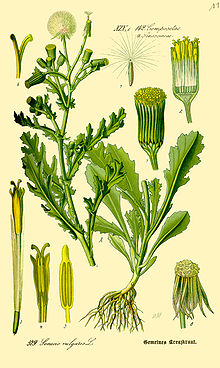Senecio
| Senecio | |
|---|---|
 |
|
| Senecio vulgaris, an illustration from 1885. | |
| Scientific classification | |
| Kingdom: | Plantae |
| (unranked): | Angiosperms |
| (unranked): | Eudicots |
| (unranked): | Asterids |
| Order: | Asterales |
| Family: | Asteraceae |
| Subfamily: | Asteroideae |
| Tribe: | Senecioneae |
| Subtribe: | Senecioninae |
| Genus: |
Senecio L. |
| Type species | |
|
Senecio vulgaris L. |
|
| Species | |
|
Some 150; see text. |
|
| Synonyms | |
|
Dendrosenecio |
|
Some 150; see text.
Dendrosenecio
Jacobaea L.
Vendredia Baill.
Culcitium Humb. & Bonpl
Senecio /sᵻˈniːʃi.oʊ/ is a genus of the daisy family (Asteraceae) that includes ragworts and groundsels. The scientific Latin genus name, , means "old man."
Variously circumscribed taxonomically, the genus Senecio is one of the largest genera of flowering plants. The traditional circumscription of Senecio is artificial, being polyphyletic, even in its new circumscription which is based on genetic data. Despite the separation of many species into other genera, the genus still contains c. 1250 species and is one of the largest genera of flowering plants. As no morphological synapomorphies are known to determine which species belong to the genus or not, no exact species numbers are known. The genus has an almost worldwide distribution and evolved in the mid to late Miocene.
...
Wikipedia
